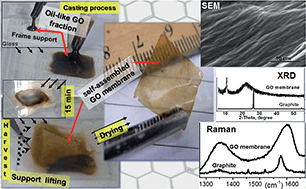Versatile self-assembled graphene oxide membranes obtained under ambient conditions by using a water–ethanol suspension†
Abstract
Nowadays there is a special interest in synthesising well-controlled self-generated graphene oxide (GO) membranes by scalable, cheap, mild and non-toxic synthesis pathways without negatively affecting their remarkable properties. Keeping this in mind, in this study we report a low cost and scalable pathway that can be used for preparing free-standing GO membranes by a self-assembly process under ambient conditions at an air–liquid interface of an isopycnic sorted GO water–ethanol fraction. The precursor GO suspension used for the preparation of this membrane-forming fraction is obtained by subjecting graphite to a more active-protected oxidative exfoliation, in which non-toxic and non-hazardous gases are generated. To improve the exfoliation and to obtain the isopycnic separation of well-defined GO fractions, ultrasonication and centrifugation are used. The prepared self-assembled GO membranes with controllable thickness are strong enough to be harvested in a simple way. The tunability of the morphological, structural and optical properties of the membranes is obtained by varying the self-assembly time. A structural model for the membrane formation via the self-assembly process is also proposed. Since during the self-assembly process mild conditions and non-toxic components are used, this method can be successfully applied in specific areas like the fabrication of biohybrid platforms or environmentally friendly devices.



 Please wait while we load your content...
Please wait while we load your content...